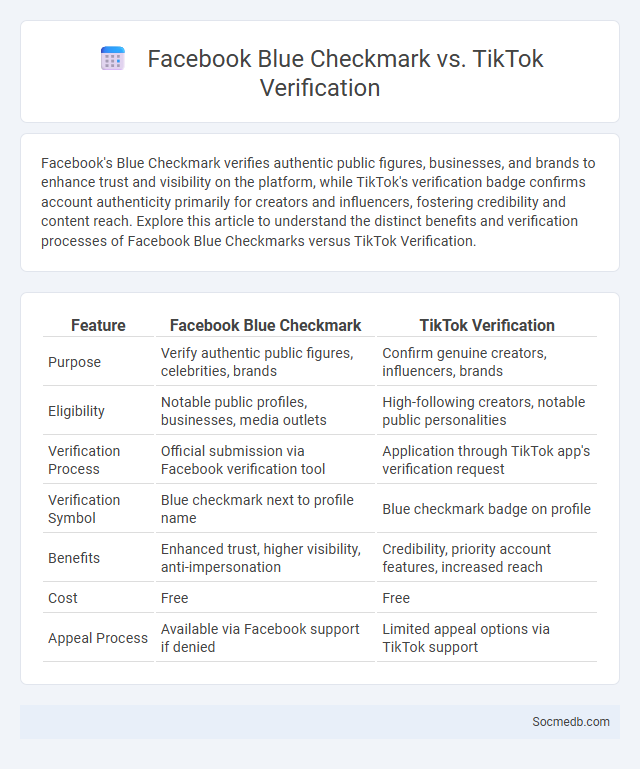
Photo illustration: Facebook Blue Checkmark vs TikTok Verification
Facebook's Blue Checkmark verifies authentic public figures, businesses, and brands to enhance trust and visibility on the platform, while TikTok's verification badge confirms account authenticity primarily for creators and influencers, fostering credibility and content reach. Explore this article to understand the distinct benefits and verification processes of Facebook Blue Checkmarks versus TikTok Verification.
Table of Comparison
| Feature | Facebook Blue Checkmark | TikTok Verification |
|---|---|---|
| Purpose | Verify authentic public figures, celebrities, brands | Confirm genuine creators, influencers, brands |
| Eligibility | Notable public profiles, businesses, media outlets | High-following creators, notable public personalities |
| Verification Process | Official submission via Facebook verification tool | Application through TikTok app's verification request |
| Verification Symbol | Blue checkmark next to profile name | Blue checkmark badge on profile |
| Benefits | Enhanced trust, higher visibility, anti-impersonation | Credibility, priority account features, increased reach |
| Cost | Free | Free |
| Appeal Process | Available via Facebook support if denied | Limited appeal options via TikTok support |
Understanding Social Media Verification: An Overview
Social media verification involves confirming the authenticity of a user's account, often indicated by a blue checkmark on platforms like Twitter, Instagram, and Facebook. This process helps distinguish genuine public figures, brands, and organizations from impersonators, enhancing trust and credibility. Verification criteria typically include account authenticity, uniqueness, completeness, and public interest.
Facebook Blue Checkmark: What It Means
The Facebook Blue Checkmark signifies a verified account, indicating the authenticity of public figures, celebrities, brands, and organizations. This badge helps users distinguish genuine profiles from impersonators, enhancing trust and credibility on the platform. Verification requires meeting Facebook's criteria, including account completeness and adherence to community standards.
TikTok Verification: Key Features and Criteria
TikTok verification highlights authenticity through a distinctive blue checkmark, ensuring users recognize genuine accounts of public figures, brands, and creators. Key features include verified status enhancing credibility, prioritized content distribution, and access to advanced platform tools. Criteria for verification involve account completeness, adherence to community guidelines, consistent activity, and notable public interest or influence.
The Evolution of the Blue Checkmark Symbol
The blue checkmark symbol on social media platforms initially served as a verification tool to distinguish authentic profiles of celebrities, public figures, and brands, enhancing trust and credibility online. Over time, its significance has evolved to represent verified identity, influence, and access to exclusive platform features, reflecting shifts in social media dynamics and user engagement. This evolution highlights how digital identity verification adapts to address issues of impersonation, online security, and user authenticity in an increasingly connected world.
Eligibility Requirements: Facebook vs TikTok
Eligibility requirements for Facebook mandate users to be at least 13 years old with a valid email or mobile number during sign-up. TikTok also requires users to be at least 13 years old but emphasizes parental consent for users under 18 and restricts certain age groups from accessing specific content features. Both platforms implement measures to verify authenticity, but TikTok enforces stricter guidelines for age-appropriate content to protect younger users.
Application Process: Step-by-Step Comparison
The application process for social media platforms varies significantly, with Facebook requiring identity verification while Instagram focuses on email and phone number confirmation. LinkedIn's step-by-step process emphasizes professional information and skill endorsements, optimizing your profile for networking opportunities. Knowing these differences helps you tailor your application approach, ensuring smoother access across platforms.
Benefits of Being Verified on Facebook and TikTok
Being verified on Facebook and TikTok enhances brand credibility and trustworthiness by displaying the blue checkmark, signaling authenticity to users. Verified accounts experience increased visibility and engagement, as both platforms prioritize verified profiles in search results and content recommendations. This status also provides access to exclusive features such as advanced analytics, content monetization tools, and improved customer support, empowering creators and businesses to grow their online presence effectively.
Common Misconceptions about Verification
Verification on social media platforms like Instagram, Twitter, and Facebook is often misunderstood as a status symbol rather than a tool for authenticating genuine accounts. Many believe verification guarantees immunity from fake news or content censorship, but its primary function is to prevent impersonation and enhance credibility. You should focus on understanding that verification signifies identity validation, not elevated privileges or content endorsement.
Challenges and Controversies Surrounding Blue Checkmarks
Blue checkmarks on social media platforms symbolize verified authenticity but often spark challenges related to misuse, impersonation, and inequities in the verification process. Your trust in these badges can be compromised due to inconsistent criteria and the occasional appearance of fake or misleading checkmarks. The ongoing controversies highlight the need for platforms to enhance transparency and improve verification methods to maintain credibility and user confidence.
Choosing the Right Platform for Brand Authentication
Choosing the right social media platform is crucial for effective brand authentication, as each platform offers unique tools and audiences that enhance your credibility. Instagram provides visual storytelling to showcase authentic brand aesthetics, while LinkedIn strengthens professional trust through endorsements and detailed company profiles. Understanding your target audience's preferences ensures your brand's authenticity resonates clearly and builds lasting loyalty.
 socmedb.com
socmedb.com